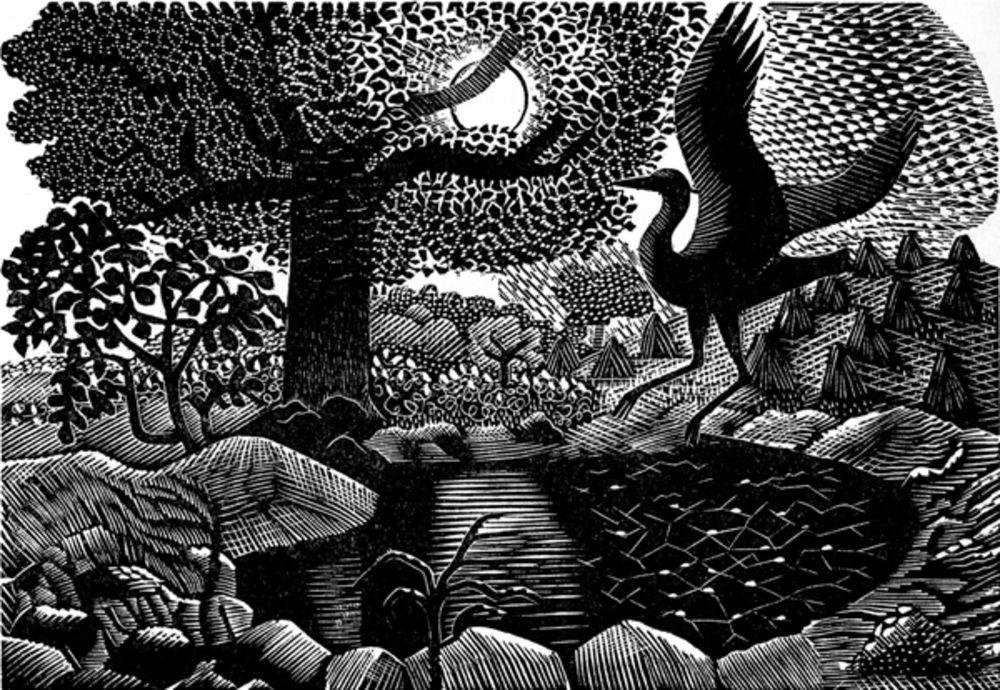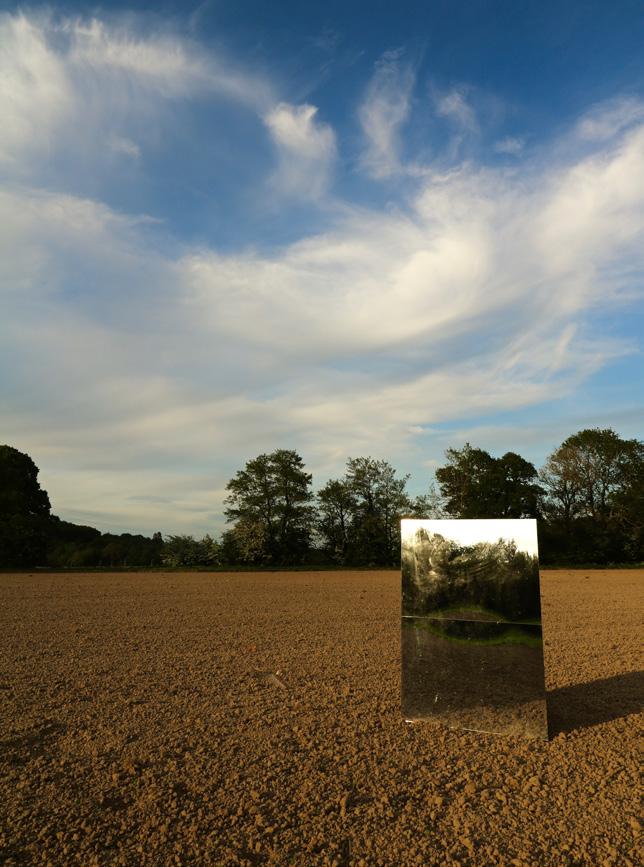
10 minute read
A Mirror to Nature: Gilbert White’s Ecological Revolution James Burkinshaw
A mirror toNature GILBERT WHITE’S ECOLOGICAL REVOLUTION
James Burkinshaw TEACHER OF ENGLISH
American poet, James Russell Lowell described I also find the word “conversation” fascinating here. White Gilbert White’s Natural History and Antiquities of was no anthropomorphist (except, perhaps, when it came to Selborne as “the journal of Adam in Paradise”. Timothy, his pet tortoise), but he was extraordinarily alive to It is a delightful image: the gentle, eighteenththe subtleties of animal behaviour and the complexities of the century parson wandering the woods and relationships between species and environments: “The language downs of his quiet corner of rural Hampshire, a natural of birds is very ancient and, like other ancient modes of speech, landscape that he observed in such intricate detail and with very elliptical; little is said but much is meant and understood.” such a sense of wonder. White saw animals as having an inner existence independent
Adam’s expulsion from Paradise, in the Book of Genesis, of humans. They were not Cartesian machines there to be represents our species’ agonising alienation from the rest of controlled and exploited (“ipsa scientia potestas est”); they were nature. The instrument of our Fall is Knowledge: human selfcreatures as complex and, ultimately, unknowable as we were. consciousness. However, 2,000 years after the Genesis narrative Indeed, when White is paying attention to detail, he is was written, philosopher Francis Bacon claimed that it was paying respect. That is why it is so important to him to find the knowledge that held the key to human power right words - not just “a few synonyms”. His over nature ("ipsa scientia potestas est") in his biographer Richard Mabey notes that he “never Meditationes Sacrae (1597). Bacon helped shape WHITE SAW openly appropriated (animals’) lives as evidence a scientific revolution, predicated on human ANIMALS NOT for any moral or theological theory; they are mastery of nature. A century and a half later, AS CARTESIAN respected for themselves.” For that very reason, Gilbert White would pioneer an ecological MACHINES TO White is conscious that he must be objective, not revolution based on respect for the natural BE EXPLOITED romanticise what he is seeing: “It is the hardest world. BUT CREATURES thing in the world to shake off superstitious
White was suspicious of an over-reliance on AS COMPLEX prejudices; they are sucked in as it were with our reason and abstraction: “Bare descriptions and AND ULTIMATELY mother’s milk . . . become so interwoven into our a few synonyms . . . all that may be done at UNKNOWABLE AS very constitutions that the strongest good sense is home in a man’s study but the investigation of WE WERE. required to disengage ourselves from them.” the life and conversation of animals is a concern White was sensitive to the intricacy of the natural of much more trouble and difficulty and it is not world, the essential role played by its most to be attained but by the active and inquisitive.” His dismissive apparently humble denizens: “The most insignificant insects and reference to “synonyms” reflects his awareness of the limitations reptiles are of much more consequence and have much more of terminology to truly characterise the complex nature of what influence in the economy of nature than the incurious are aware is being described. For Gilbert White, “trouble and difficulty” of . . . Earth worms, though in appearance a small and despicable were part of the point: knowledge had to be experienced, had link in the chain of nature, yet, if lost, would make a lamentable to be earned. chasm . . . a good monography of worms would afford much
Eric Ravilious, The Tortoise in the Kitchen Garden from ‘ The Writings of Gilbert White of Selborne’, ed., H.J. Massingham (London, The Nonsuch Press, 1938)
entertainment and information at the same time.” It is passages such as this marvellous encomium to the earth worm that have led to White’s recognition in our own century as the godfather of ecology. At the heart of his ecological world view was his sense of sympathy. White would go out of his way to avoid harming the creatures he observed; he describes coaxing crickets out of their hiding places: “a pliant stalk of grass, gently insinuated into the caverns will probe their windings to the bottom and quickly bring out the inhabitants; and thus the humane enquirer may gratify his curiosity without injuring the object of it.” Key words here are “gently” and “humane”: to treat other species with respect and care is to be worthy of our humanity. The “object” is never objectified by White.
The Reverend White’s Natural History is notable for its lack of scriptural references. The Selborne landscape is his sacred text. In his introduction, he seeks to “induce any of

Eric Ravilious, Bird-Nesting from ‘The Writings of Gilbert White of Selborne’, ed., H.J. Massingham (London, The Nonsuch Press, 1938)

Eric Ravilious, A Rust-Coloured Ferruginous Light,from ‘The Writings of Gilbert White of Selborne’, ed., H.J. Massingham (London, The Nonsuch Press, 1938),
his readers to pay a more ready attention to the wonders of the Creation, too often overlooked as common occurrences.” The sense of finding wonder in “common” things – earth worms, and crickets – reminds the reader of William Blake. Like Blake, White is more a man of the seventeenth century than the eighteenth (they shared a love of Milton’s poetry); a key influence was John Ray’s Wisdom of God (1691), a classic of “physico-theology” (or natural theology) that sought to “illustrate the glory of God in the knowledge of the works of nature or creation”. White himself often combines scientific diction with poetic imagery to resonant effect: “December 10th being bright sunshine, the air was full of icy spiculae (crystals) floating in all directions like atoms in a sun-beam let into a dark room” Some have compared White to the Romantic poets of the next generation, but the sharpness and clarity of his observation and the precision of his imagery are more akin to the Modernist poets of the early twentieth century; his description of the way in which “white butter flies gather in flocks on the mud of the puddles” anticipates the “luminous details” of Ezra Pound’s Imagist masterpiece (“The apparition of these faces in the crowd:/Petals on a wet, black bough”) by a century and a half.
This creative tension between scientific precision and poetic vision, empirical detachment and empathetic connection, is what gives White’s writing its resonance, as in this description of baby swifts: “while we contemplated their naked bodies, their unwieldy disproportioned abdominal and their heads too heavy for their necks to support we could not but wonder when we reflected that these shiftless beings in a little more than a fortnight would be able to dash through the air almost with the inconceivable swiftness of a meteor; and perhaps in their emigration must traverse vast continents and oceans as distant as the equator.” It is the mystery of the birds’ “strong impulse towards migration” that fascinates Gilbert White more than anything else in the world, “imprinted on their minds by their great Creator ... I reflected that, after all our pains and inquiries, we are yet not quite certain to what regions they do migrate”. In the face of the unknown and perhaps unknowable, it was often poetry to which White turned (in which “little is said but much is meant and understood”). In his poem, ‘The Naturalist’s Summer-Evening Walk’, he implores the swallow “say where your hid retreat/When the frost rages and the tempests beat/Whence your return, by such nice instinct led/When spring, soft season, lifts her bloomy head?/ Such baffled searches mock man’s prying pride,/The God of Nature is your secret guide!” Who, indeed, was Gilbert White’s “God of Nature” and why was he “secret”? In such lines, it is possible to understand how White could have been such an influence on two men as seemingly opposite as the pantheistic mystic Samuel Taylor Coleridge and the evolutionary biologist Charles Darwin.
Although so much of White’s preoccupation was with small, “common” things such as birds and insects, he loved the dramatic sweep of the South Downs: “Though I have now travelled
the Sussex downs upwards of thirty years, yet I still investigate that chain of majestic mountains with fresh admiration year by year and I think I see new beauties every time I traverse it... a noble view of the wild or weald on the one hand and the broad downs and sea on the other.” Three hundred feet above the vicarage loomed the densely wooded slope, Selborne Hangar, which to this day retains its sense of sublimity; White describes how “the hanging beech-woods begin to be beautifully tinged and to afford most lovely scapes, very engaging to the eye and imagination. They afford sweet lights and shades. These scenes are worthy the pencil of Reubens.” With his reference to “scapes”, “eye”, “imagination” and “shade”, he sounds more like an artist than a man of science. Indeed, like physico-theological forerunners such as John Ray, White saw no boundary between science and art, fact or feeling. In The Natural History, he will frequently shift without warning from impeccably precise Latin taxonomy to colloquial names that, read aloud, create an almost incantatory quality: “stinking hellebore, creeping bilberries, round-leaved sundew, perfoliated yellow-wort, true-love or oneberry, golden saxifrage, fellwort, toothwort, wild lathyrus, ladies traces, spurge laurel, dwarf elder, danewort.” White brings a similarly vertiginous quality to his vivid evocation of rooks that “rendezvous by thousands over Selborne – down, where they wheel round in the air and sport and dive in a playful manner . .. very engaging to the imagination and not unlike . .. echoing woods or the rushing of wind in tall trees or the tumbling of the tide upon a pebbly shore . . . they retire for the night to the deep-beechen woods.” The epic quality of such writing owes much to White’s own literary tastes; when he lyrically describes “the sun at noon . . . shed(ding) a rust-coloured, ferruginous light” he compares it to “Milton’s noble simile of the sun in his first book of Paradise Lost”. However, White can also be an artfully selfdeprecating writer; soon after publication of The Natural History, he wrote ‘Poem to Myself, Commencing Author’ which includes the lines: ‘Who now reads Cowley? The sad doom await/Since such as these are now may be thy fate.” In a line worthy of Dr Johnson, he describes compiling the index for his Natural History as “an occupation full as entertaining as that of darning stockings, though by no means so advantageous to society.” As with Johnson, we often get the sense that White’s humour masks a deep-seated sadness; in his poem, ‘The Naturalist’s Summer-Evening Walk’, he discovers that “These, Nature’s works, the curious mind employ/Inspire a soothing melancholy joy” the image of a joy that is both melancholy and soothing suggests an extraordinarily complex response to the natural world on the part of the poet. The joy and the melancholy are indistinguishable from each other; both are essential to the writer’s sense of self and to his sense of empathy with the birds, insects and earth worms he observes.
We began this article with Lowell’s description of White’s Natural History as “the journal of Adam in Paradise”. It is possible to read this as a critique as well as a tribute. Was White trying to evade history, tucked away in his self-enclosed world of Selborne village? Is The Natural History a work of escapism? Certainly, there are few references to the wider world in the book, other than concern expressed for a young local man pressganged to fight the French (“he was bred a carter and never had any connection with sea affairs”) and a single perplexed comment on the political earthquake of the French Revolution (“these strange commotions”). The great nineteenth century nature writer, Richard Jefferies (an admirer of White’s) regretted that “he did not leave a natural history of the people of his day. We would then have had a picture of England just before the beginning of our present era and a wonderful difference it would have shown.” However, locals remembered fondly a friendly, caring, somewhat eccentric parson, his “animated conversations with villagers ... with his peculiar way of shrugging his shoulders”; most of all, they recalled with gratitude his energetic efforts on their behalf to fight the enclosure of the common land. 300 years after Gilbert White’s birth (on 18th July, 1720), there seems nothing escapist about ecology. Although he ended his Natural History with the words “I shall here take a respectful leave of you and natural history together”, we have not taken our leave of him. We recognise more than ever the quiet urgency of his message that, if we are to save ourselves and the planet we live on, we have to find a more respectful and empathetic way of living among our fellow creatures.










